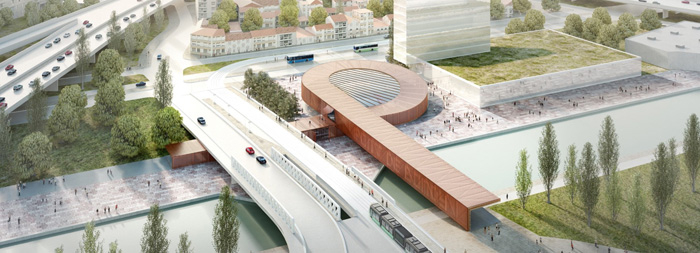Autodesk’s refocus on construction has never been so clearly evident than at this year’s annual user event in Las Vegas. Using all possible technologies, Autodesk is seeking to digitise design and fabrication, while easing collaboration and enhancing the process with machine learning. By Martyn Day
Under its previous CEO, Carl Bass, Autodesk doubled down on development in the highly competitive manufacturing area, producing products such as Fusion and embracing digital fabrication. Of course, as this is Autodesk we are talking about, the company covers multiple markets, so this wasn’t the only area which developed — the ground was laid for cloud and the move to subscription.
The new CEO, Andrew Anagnost, now in his second year in the role, has made significant changes, de-focusing from products that are not yet commercial, culling ones that were not revenue generating and investing in the products that are currently being used by customers. The commitment to the cloud has continued and the company has made a number of key acquisitions.
The one area Anagnost has always highlighted is the potential for the construction market to revolutionise the way it works, and benefit from digital fabrication and automation. From what we, at AEC Magazine, have seen on our travels this month, he is not alone in this thought. Bentley Systems, Microsoft, Dassault Systèmes, Siemens, Trimble and others have all placed construction as their key market. Next year promises to be a real-life Game of Thrones, as we will witness the battle of the CAD giants for the collaboration hub, the construction BIM and the best connection to digital fabrication. Winter is coming — well it is November, what do you expect!
Anagnost keynote
As if to prove automation will not take all our jobs, the keynote opened with people dancing with a robot arm. Anagnost started with automation and concentrated on how it can help with making things ‘better’.
In 1900 40% of the USA worked in farming; today it’s 2%. The value chain for food extends well beyond farm to market, but we now have more access to food than ever before – cooking shows, plant-based meats, gluten free everything, etc. Farming is making better use of land, producing great yields and repetitive jobs have been replaced. Now we have organic farmers as well as industrialised food production.
Transportation is going to change. The US currently has 4 million people employed as drivers, and while in the future this will decrease, there will be more opportunities, moving more people, more efficiently than ever before. How many BIM managers were there ten years ago? Industries change, new roles are created.
Anagnost took a look at his home town of LA and how it will build necessary infrastructure to host the Olympics in 2028, while leaving a positive legacy for the city’s inhabitants. Anagnost looked at technologies like Autodesk BIM 360, which can provide collaboration with real time feedback, showing constructability, cost and risk, building a Digital Twin. This also works for manufacturing, with everyone working together, looking at the options for a design, with the computer choosing those that are easiest to make, replace etc.
We operate today on designing and manufacturing in constraints which are self-imposed. Using automation we can free ourselves from this, as the computer will stop design hazards before they ever happen and customers can design these tools themselves.
Borduin keynote
Over the summer, Autodesk lost a number of long standing execs, including Jeff Kowalski, the company’s CTO. His replacement, Scott Borduin, is actually a long-standing Autodesker who once held the role of CTO.
Borduin talked about how data flow and automation can bring benefits. But historically, data flow is hard when the data is getting bigger and every firm has unique workflows.
Borduin said that Autodesk, on its journey to the cloud, realised that moving a product like Revit to the cloud would only change the location of the application. It needed to develop a solution that would allow customers to define their own workflows and provide a pipeline for that data to flow and for tools to plug into, even those of its competitors. Part of this is Forge, Autodesk’s development platform, which enables applications to access and manipulate design data held in Autodesk’s cloud.
Dr Erin Bradner, Autodesk’s robotics expert, then gave an example of a concept for a landing vehicle, designed by JPL to investigate one of Jupiter’s icy moons. Using Autodesk Generative design tools, JPL removed one third of the weight in the design, but also designed for additional competing issues, such as manufacturability and cost.
By analysing dozens of designs, optimising for 3-axis and 5-axis milling, making the generative design manufacturable with today’s technologies, the JPL engineers were only presented with design options that fitted their criteria. They didn’t waste time looking at designs that failed to meet their performance envelope. This was pretty amazing stuff. Looking at a single part, Autodesk’s generative software can give geometry solutions which fit the manufacturing resource available: additive (3D print), cast, 5-axis or 3-axis CNC.
Moving on to buildings, Autodesk has been helping Daiwa House Group (daiwahouse.com/english) solve challenges around Japan’s chronic shortage of build space. The Japanese company builds houses, care homes, hospitals, shopping complexes – pretty much anything – and is focussed on automation and BIM to fabrication.
When spaces become available, Daiwa House uses generative design tools to identify the best small pockets of land and develop speculative uses. They then approach the land owners to see if they are interested. The software assesses plots quickly and runs through many iterations until the best design and return on investment is identified. As each project is done, machine learning is applied to enhance future proposals.
At the end of the presentation, Anagnost announced that the company will expand from offering product-based training to role-based certifications, so in addition to Revit, customers could also qualify as a BIM manager.
Anagnost felt that upskilling for careers is more important than how to run a specific individual product. Autodesk will move from offering physical training to more digital training, with a new lefarning engine in development. The company is working with four US labour unions and firms such as Village Capital, Nexus Edge, blendoor and sorcero.
Anagnost concluded that automation will need new skills, bring better jobs and there will be a scarcity of skills, not a scarcity of jobs. The talk finished with three new terms, Adaptability, Resilience and Community, saying he and the company felt they had a moral and social responsibility to address the challenges and help its customers.

AEC keynote
Game engine visualisation and Virtual Reality (VR) is becoming big business in AEC. At this year’s AU, Autodesk announced a strategic partnership with Unity, which will provide the developers of the real time 3D development platform with sub-level access to Autodesk’s applications to integrate its VR tools. This will lead to seamless integration with Unity, allowing geometry, meta data, textures to flow into VR environments without any need for end-user translation.
Eventually the data flow will be both ways with designers being able to change the designs in Unity and have that flow back to update products such as Revit. With a target date of October 2019, the company says that some of the links will be delivered earlier.
This is an unusual move for Autodesk, as it has a suite of VR/AR developers working on tools for its platforms, including Epic Games (Unreal Engine), IrisVR, Enscape, Lumion and Twinmotion. Autodesk also had/has its own game engine viz / VR tool called Revit Live. Selecting one developer to gain special access isn’t usually in Autodesk’s playbook, unless it has bought them. With Unity that is highly unlikely.
Unity does have two advantages over the others in that, for the last year, it was the first developer to access the Autodesk FBX SDK for Max and Maya, seamlessly sharing assets for in-game iteration. It’s possible the success of this brought Unity closer to the development teams. The other being that Unity supports 28 different interactive target platforms.
It seems Autodesk’s efforts in game engine viz and VR for the AEC sector will be phased out, as they were never that competitive to the third party partner applications in the market. This is perhaps the first sign of Autodesk choosing to vacate the market, to concentrate R&D dollars on something they have better competency on, or greater opportunity. However, it does somewhat leave Unity’s competitors at a disadvantage.
Traditionally Autodesk has bought the one developer to own that space. I can’t help but feel that this is some kind of dereliction of duty of a software developer. However, with ESRI and now Unity, Anagnost’s tenure looks to be different to any previous Autodesk CEO, in that a strategic partnership is sometimes good enough. Unity’s Pro offering does come in at the high side of its competitors.
Jim Lynch, Autodesk’s vice president & general manager, construction business unit, talked about the benefits of adopting a manufacturing-led mind set to defeat the industry’s well documented inefficiencies. Added to those problems, 95% of firms can’t find enough skilled workers, 20% of the industry’s work force is about to retire and 35% of architects are over 55 years old. Part of the answer is deploying new technology and workflows. Autodesk is concentrating on collaboration tools, automation tools and predictive tools to look ahead and identify trouble before if happens.
A raft of new features related to Autodesk BIM 360 was shown on stage:
• A new BIM 360 ‘site collaboration for Civil 3D and Revit’ was shown, linking civil data with Revit dynamically.
• Model co-ordination in BIM 360 can now run automatic clash detection between models.
• A new PlaceMe tool lets you place an icon within a 2D drawing and call up a 3D view of where that is in the 3D model.
• New timelines for tracking project progress and collaboration.
• New approval workflow process in BIM 360, initiate and sign reviews, organised in sets.
• Assemble Systems for quantities and building elements in BIM 360.
• Cost management model added to BIM 360 linked with change orders.
• A new freeform rebar tool to automate mundane tasks.
• Customisable check lists for issues, identify causation and resolution.
• Dashboards all now in one place.
• Reports can be sent to anyone.
• Machine Learning to analyse the data.
• Predictive analytics for projects now ready for use.
Autodesk customers — Mott MacDonald, Lera Consulting Engineers and Paric — all gave examples of how they used Autodesk technology to innovate within recent projects.
Project Plasma
Remember that big article we did on Project Quantum, the future of Revit and the cloud? (tinyurl.com/ quantum-AEC). Well, after going into stealth mode, the project has been re-branded Project Plasma and is back on track. Our understanding is that some of the technologies that were being developed were going to be so useful to all Autodesk customers and products that some of that technology needed to be examined in a platform context, as opposed just to Autodesk’s Quantum sphere.
By all accounts the development work is now looking really good. We hope to bring you a deeper insight into where the project has got to and the basic benefits of collaborative working and connecting design to digital fabrication.
ESRI partnership
One of last year’s biggest announcements was Autodesk’s strategic agreement with ESRI to co-operate and work together. The development teams have been hard at work and the fruits have been first seen in the release of ‘Autodesk Connector for ArcGIS’, which links Autodesk InfraWorks with the ArcGIS online system. This capability improves BIM workflows by directly connecting to GIS data in a more seamless way, versus an import with no ability to refresh if GIS data is updated. All attributes of the GIS data are added to the InfraWorks model, making the 3D context model more robust and accurate.
ESRI will also be linking ArcGIS’s online, vector, image and map data to Civil 3D, Map and AutoCAD. ESRI will add support for Revit at some point too. This ability was demoed earlier this year at ESRI’s user event in London. Both companies are working on an integration between ArcGIS and Autodesk BIM 360. The partnership will be really exciting for those wishing to design in context or access geographically sorted data. There is a special offer for Autodesk customers to have a complimentary subscription to Esri ArcGIS till the end of 2019 (tinyurl.com/GIS-free-AEC).
Robots in Construction
On day one, AU hosted a special ‘Connect & Construct Summit’ which featured a whole day of future gazing talk topics, together with hands-on workshops.
There was quite a bit of content looking at current experimentation with automation onsite and in factory settings. On the show-floor, some of the work Autodesk has completed with customers was being demonstrated, including a shipping container with two robot arms which had been used to experiment in creating and assembling structures.
Autodesk is bringing its knowledge from the manufacturing space into the AEC world and working with R&D teams from large architecture firms to experiment and build using new materials and production methods. Autodesk’s Build space facility in Boston featured heavily and it now seems to be recognised by architectural firms in the US as a place to go and try out the impossible.
Autodesk Forge
One of the key messages of the conference was that Autodesk web development platform, Forge, was for developers, dealers, customers — anyone — to develop and create their own workflows and products. It’s taken quite a while to get where it is today but there are now a number of examples of customers and developers who have deployed Forge components to share, analyse or collaborate their designs.
Developers have wanted to run with some of this technology but have been frustrated with the rate of development of certain components, together with a meandering business model. A key component being Revit.io – a cloud version of Revit which developers can call on to access Revit functionality. When this stabilises, I expect we will see a raft of commercial applications based on Forge.
Autodesk has hired ex-Google cloud platform guru Sam Ramji as VP cloud platform, to come in with deep cloud experience to stir up Autodesk’s development and ensure Forge is an enterprise level, robust cloud API. Ramji was incredibly impressive on stage and can be watched here (tinyurl.com/ramji-AEC)
Rebel dealers
In recent years, Autodesk has been reducing the number of dealers it has worldwide and the margins on product sold and subscriptions. The net fallout has been approximately 600 resellers have either sold up or closed up shop. As Autodesk drives the subscription model and increasingly goes direct, the days of the small Value Added Reseller (VAR) have been numbered.
What we have seen is a number of very large resellers have continued, usually offering expanded services, but many of these are now struggling with the loss of margin on commodity product, especially AutoCAD LT. One large and respected European reseller and developer, Graitec, broke ranks just before the show to offer its own, in-house developed IntelliCAD-based clone called Advance CAD, as an alternative to AutoCAD LT for DWG editing at just £300. (graitec.com/advance-cad). This is a significant departure for a channel that has traditionally been very loyal. We expect others to follow.
Perhaps the 2D drawing market will, after decades of domination, now see increased competition, with perpetual licences costing a fraction of a full equivalent Autodesk subscription. There are a large number of mature DWG work-a-likes available including BricsCAD, Graebert ARES, Dassault Systèmes Draftsight (created by Graebert) and ZWCAD.
We understand that Autodesk’s planned significant price hike in maintenance to ‘persuade’ customers that ‘Subscription makes more sense’, comes into effect in March 2019. This will see 20% added to the cost of maintenance for non-subscribed applications. In general, this is to be seen in the context of a general trend of increased cost of ownership for Autodesk’s products, for those outside of subscription all the way to those with enterprise licences.
It will be interesting to see if there is any dent in the subscription rate with customers seeking alternatives or if the stickiness of customers and their AutoCADs proves durable.

Conclusion
Autodesk University this year was all about BIM 360 and Forge. A monumental effort is being put into both those elements as Autodesk pushes itself to deliver enterprise quality platforms for collaboration and application development. Just as we were going to press, Autodesk announced a breathtaking $875 million acquisition of PlanGrid, a developer of construction productivity software that delivers blueprints, project docs, markups, RFIs etc. on synchronised mobile devices. I suspect this is the biggest acquisition in Autodesk’s history. If there was any doubt about the company’s focus on construction, here’s 875 million reasons to believe them.
The construction market is certainly heating up with big developers hoping to get a slice of the market. Oddly, everyone seems to be going for the same core areas – cloud-based management, co-ordination and collaboration. I guess when everyone identifies inefficiencies in a federated or fractured process, it’s the go to destination to look for a solution. However, there will also be battles over the construction BIM and how to connect design to digital fabrication as well as interoperability – CAD companies have inherently failed to be truly open while preaching that they are. As the battle moves from desktops to the cloud, it will be interesting to see if access to APIs and data is or isn’t shared amongst competitors.
If you enjoyed this article, subscribe to our email newsletter or print / PDF magazine for FREE






